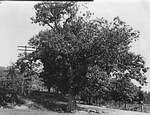Oak Tree Road
As we drive down Oak Tree Road to Tappan, it’s hard to imagine a time when the road didn’t exist. But in the 18th and early 19th century the only way to Tappan was by a “cow path” north of the present Oak Tree Road, down the hill to the west, and across the Sparkill Creek by a log.
On Feb. 9, 1836 Nicholas Gesner mentioned the “new road,” which was first called Tappan Road, and later came to be called Oak Tree Road after the large tree which used to stand at the northeast corner of the crossing with Route 340. We don’t know how long the road had existed when he made the diary entry.
That same year Abraham Jacob Post, a prominent local farmer, gave land for a new Palisades School to be located on the same property as the present Community Center. This school was abandoned in 1867 when the present structure, the Old School, was built on the same site.
In the late 1850s Abraham Post gave pieces of land along the south side of Oak Tree Road, west of the Old School, to seven of his children. The pleasant frame houses which were built on the plots by five of the children between 1857 and 1867 are still known as Post Row. Mildred Post Rippey was the last Post descendant to live in one of the Post houses.
Farther down the hill was the large farm of David Mann. In the 1860s he sold several sections of his property to wealthy newcomers who built large houses looking west over the valley. They included Floyd Bailey, who built Valley View on the south side, and Isaac Sears, whose house was on the north side. Later the Marder house was built on the north side of the road, followed by the Perry house. After selling his land David Mann announced that he would never again do a day’s work for anyone.
Oak Tree Road was still unpaved in 1913, when Constance Lieval Price walked the road to school from the Lieval house at the bottom of the hill. Her family had an artificial flower factory behind the house. She mentions the Oak Tree Hotel, located on the corner of route 340, the huge oak tree that gave the road its name, and Valley View, which now belonged to James Wallace, with its extensive lawns and formal flower beds behind the low stone wall.
Changes to the road came slowly. In 1930 the new red brick school was built across the road from the old one. Heyhoe Woods Road was created in 1940 by five families from the city, many of them academics, who built modern houses on the road. The pace of change increased after World War II. In the mid 1950s the old Wallace estate, which had for a time belonged to a flamboyant character named Charles Nessler, the inventor of the permanent wave, was replaced by Palisades Gardens, a development of 75 houses. The building of the Palisades Parkway in 1957 destroyed George Mann’s old house and straightened Oak Tree Road. At the end of the decade Swan Street, a small development on the south side of the road, was created. A new post office was built on the corner near the Palisades Library in 1962.
In 1970 Palisades Gardens, a residence for senior citizens, was erected on 18 acres of the former Perry estate, partway down Oak Tree Road on the right. The building had 135 residence units and a population of approximately 200 elderly residents. The building is now the home of the Esplanade, an independent-living complex.
Over the years there were threats to the historic, small-town atmosphere of Oak Tree Road. In 1978 Reg and Dossi Thayer spearheaded a successful effort to save the Palisades Triangle, a patch of woods bounded by Route 9W, Oak Tree Road and Closter Road, from development. The Triangle had been a pasture known as “The Timothy Meadow,” which had been used as a playground and a ball field. Most of it belonged to the Ratcliff family, who put it on the market for $50,000 in 1978. Learning that it was zoned for commercial development, the Thayers acquired from the owners, for $1,000, a six‑month option to purchase the property. They learned that New York State would contribute $37,500 if they could raise the other $12,500 and persuade the Town of Orangetown to accept the property as a gift. The Town accepted the gift and the Triangle Park was created in 1979. One mailing to all Palisades residents plus one article in 10964 had quickly raised over $17,000 from 142 donors. [The extra money was given back.]
In 1985, just past the intersection with Route 340, two new subdivisions named White Oak and Red Oak were built. They included thirty new houses. Another smaller development of twelve houses, named Lauren Road, was built across the road in 1992. This development would have been much larger if it were not for a 1987 suit brought by the Palisades Civic Association; the original plans called for 70 units on the 9.6 acre property. Dossi and Reg Thayer were also involved in the fight to ban Consolidated Freightways’ tandem‑trailer rigs from Oak Tree Road. The prospect brought the PCA and the community out in full voice, and the State Department of Transportation rejected the proposal.
Today there are plans to put more sidewalks along the road, which already has them in certain sections from the Tappan line to the Palisades Library corner. Oak Tree Road has come a long way since the picture on the previous page.



